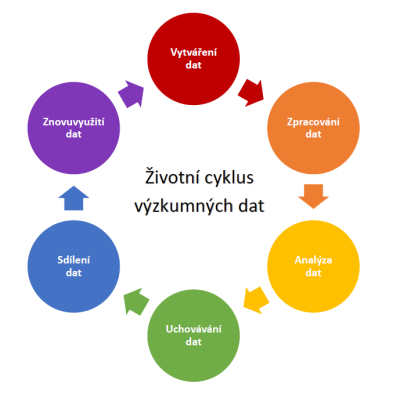Data management plan
Data life cycle
In an environment that supports open data access, the reuse of stored data is prolonged. Data is thus gaining more importance for the transfer and reproduction of knowledge, and these functions influence the concept of research.
Research data goes through its life cycle:

Source. Hanzlíková: Management of research data
The management of research data needs to be addressed in every research. The data management plan describes what will happen during their life cycle.
The data management plan (hereinafter DMP) is a document that specifies what data and how it will be created during the research and contains information about their availability and use during the research and after its completion.
The advantages of creating a DMP include:
- Helps anticipate potential problems
- Reduces the risk of duplicate work, data loss and security breaches
- Ensures accuracy, completeness and reliability of data
- It ensures the continuity and consistency of long-term projects
- Helps with data sharing
- Saves time and energy when retrieving data, updating, etc.
- Mandatory part of the project in order to ensure compliance with and control of the data policy and established principles for data access.
DMP contains and processes the following topics:
- Administrative data
- Data Collection
- Documentation and metadata
- Intellectual property protection
- Ethical and legal issues
- Storage and backup
- Long-term protection
- Access and sharing of data
- Responsibility and resources
- Budget
Part of the DMP is the self-publishing of the data set according to the set schedule. The procedure for publishing a custom dataset includes the following steps:
- Data analysis and determination of technical form
- Preparation and modification of software containing data sets for data export
- Determination of conditions of use
- Export and edit data in open format
- Explanation of the structure of exported data (ie metadata) and a description of the distribution itself
- Physical placement of data in a suitable repository
- Measure by persistent identifier
- Creating a cataloging record
Tools for DMP creation and project management
There are several tools available for DMP creation, which allow you to go through the entire DMP creation process, allow you to collaborate on the editing of a document by the project team, and a final version for easy publication using recommended templates from various financial providers.
DMPonline is a simple online tool for creating and managing DMP. (generates templates for projects of various providers)
Data Stewardship Wizard is an open source tool that accompanies the planning and compilation of DPM, the content can be edited into various outputs and further shared with other scientists (generates templates for projects, etc.)
Argos is a tool for creating DMP. The service is integrated into the Open AIRE platform.
Open Science Framework (hereinafter OSF) is an open source web platform for managing the entire project. It enables the management of the entire project cycle from planning through research execution, result reporting and archiving.
It helps teams collaborate in one centralized location and provides file hosting, version control, persistent URLs, and DOI registration.